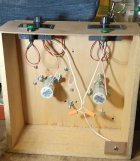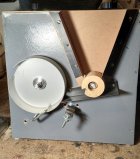And thanks for the feedback fellas. !!!!!
Install the app
How to install the app on iOS
Follow along with the video below to see how to install our site as a web app on your home screen.
Note: This feature may not be available in some browsers.
You are using an out of date browser. It may not display this or other websites correctly.
You should upgrade or use an alternative browser.
You should upgrade or use an alternative browser.
Homemade annealing machine challenge
- Thread starter archerforkids
- Start date


I used anything I had laying around for this. I did buy the motors, speed controllers, power source and cake pan.
I haven't really used it for .223 yet. I need to set the timer for the temperature first then the feeder or use a sensor to turn the feeder. For .308 I would place the cases manually on the ramp.
I don't remember what I spent but it would have been cheaper without the feeder motor. Not as pretty or fancy as others still it scratched the itch I had to make one.
Last edited:
Well this got interesting. I hooked the outfeed from the first speed controller into the infeed on second speed controller. It did a great job of synchronizing the two wheels. But for whatever reason, it slowed down the whole process. My first controller hits maximum speed at about 5%. In other words I don't have the fine tuning I had before. I unhooked the second speed controller and wired the first motor back like it was without the second motor at all. Now I'm back to full RPMs and full control of the first controller. It's like hooking up the second controller is robbing all the voltage.
Tucker65
Gold $$ Contributor
I built one and tried two speed controllers but they eventually got out of time. Now I just run one motor full speed to dump the case into the waiting position until it drops into the drum. When it drops into the waiting position it blocks a prox switch "the blue round thing" which turns the motor off. When the drum comes around, and the case drops in, the prox switch turns the motor back on to get another case ready.
Most full proof way with your current design might be to add a NPN (or PNP) “normally closed” sensor. When no case is in the flame the top/ feed motor turns. When a case is being annealed and is against the sensor, it breaks (opens) the top/feed motor circuit shutting off the feed motor. When the annealed case is pulled away from the sensor the feed motor turns on and drops a case.
Sensor I used:
wired this way —> see first post on this page;
 www.ar15.com
www.ar15.com
Sensor I used:
Amazon.com: Twidec /M12 Approach Sensor Inductive Proximity Switch PNP NO DC 6-36V, 4mm Detecting Distance LJ12A3-4-Z/BY: Industrial & Scientific
Amazon.com: Twidec /M12 Approach Sensor Inductive Proximity Switch PNP NO DC 6-36V, 4mm Detecting Distance LJ12A3-4-Z/BY: Industrial & Scientific
www.amazon.com
wired this way —> see first post on this page;
DIY Annealing Machine > Reloading > AR15.COM
I love DIY projects. SO I set out to find a DIY case annealer project. I came up pretty dry. A lot of people showing how to use hand drills and so on. No real plans on this is what I used this is what
That sensor switch is killer idea.I built one and tried two speed controllers but they eventually got out of time. Now I just run one motor full speed to dump the case into the waiting position until it drops into the drum. When it drops into the waiting position it blocks a prox switch "the blue round thing" which turns the motor off. When the drum comes around, and the case drops in, the prox switch turns the motor back on to get another case ready.
Switch got ordered.I built one and tried two speed controllers but they eventually got out of time. Now I just run one motor full speed to dump the case into the waiting position until it drops into the drum. When it drops into the waiting position it blocks a prox switch "the blue round thing" which turns the motor off. When the drum comes around, and the case drops in, the prox switch turns the motor back on to get another case ready.
Thanks
Good job - You will get this machine to work well without too much trouble. I've made a good few annealers of several different own designs.
Kkeene has the answer here, the NC proximity switch can be wired directly in circuit with the motor. The top/switched motor can be run at it's full geared down speed, so it zips round and picks up a case and sits and waits until the annealed case is dropped..
Here's a couple of my home built machines:


Kkeene has the answer here, the NC proximity switch can be wired directly in circuit with the motor. The top/switched motor can be run at it's full geared down speed, so it zips round and picks up a case and sits and waits until the annealed case is dropped..
Here's a couple of my home built machines:


Good looking machines friend. Lot of satisfaction in DIYGood job - You will get this machine to work well without too much trouble. I've made a good few annealers of several different own designs.
Kkeene has the answer here, the NC proximity switch can be wired directly in circuit with the motor. The top/switched motor can be run at it's full geared down speed, so it zips round and picks up a case and sits and waits until the annealed case is dropped..
Here's a couple of my home built machines:
Well I'm not too old to learn. Why wouldn't you cut the hot on both switches?Remember that the wiring for an NPN sensor is different than for PNP. One cuts the negative voltage, one cuts the positive.
I'll install a PNP since my old school logic says switch the hot wire going to the motor.
Here's a website I found then helped me understand them.

 www.learnrobotics.org
www.learnrobotics.org
Here's a website I found then helped me understand them.

What is the difference between PNP and NPN? - Learn Robotics
Here on the blog, we spend a lot of time working with 5 VDC sensors and controllers (Arduino, for example). And, a lot of that knowledge is a great primer for getting into Industrial Controllers like PLC’s (Programmable Logic Controllers). However, when you start working with PLC’s and 24 VDC...
divingin
Gold $$ Contributor
No offense intended here, but if you want both wheels to maintain sync, the best option is to drive the second off the first via gears or a belt (or, worst case, rubber wheels.) I'd hate to have to keep adjusting speeds as things drift.Definitely been interesting to build. Kick myself in the ass for not going ahead and designing in the second controller. I bought it but had a brain fart and decided I didn't need it. And here we are
No offense taken.No offense intended here, but if you want both wheels to maintain sync, the best option is to drive the second off the first via gears or a belt (or, worst case, rubber wheels.) I'd hate to have to keep adjusting speeds as things drift.
I'm thinking the PNP sensor is going to take out all the timing/synchronizing issues while maintaining the "fewer parts" world I try to stay in. I am all about the KISS principal. We will see in a day or two. Just waiting on that big brown truck!!
I appreciate the feedback by the way...from all y'all.
Artisan
Life is an Equation, incapable of solution.
Nice Project, excellent results. Need a peek in the back. Mine has one motor with 1 gear (upper wheel), toothed to a lower gear (lower wheel). Geared together, the wheels will always travel at the same speed. Use a volt meter, where wires attach to motors, see if voltage is the same. The two motors, are completing for the same low-voltage. How about a controller, made, to control 2 different motors at the same time? Follow the money trail.Well.... I finally got this thing built. Its been setting here for 2 weeks waiting to be test driven.
This morning, plenty of coffee, no grandpa duty, the war department is sleeping in so here we go.
And as luck would have it, the darn motors don't match each other with their speed. I have them wired to the same controller. Good solid connections. Wheels are same diameter. Everything is humming like an old Model M Farmall.
Except they don't match each other. After running for about ten minutes, the cartridge notches get out of time with each other.
I sure hope one of you fine gentleman with an electrical background can enlighten me on a simple fix. I don't want to run the motors separate with 2 different power supplies if I can keep from it.
I'll also say that at 12 bucks per motor, I probably got what I paid for.
Any help is appreciated.
2 Upgrades:
First, put 2 round adjustable feet,on the front 2 corners. Certain size cases (7.63X39 & others) will try to jump off or roll-out (sharp taper of the case does this) from piling a bunch on. Having the unit, tilted backward, a little bit, will prevent this.
Second, my upper wheel is 1" thick, bottom wheel is 3/4" thick, allows every case size to be used (even WSM), without burning the lower wheel with the torch.
An added bonus, I use Permatex Red 750 degree, mix in a very small amount of fine-sand and brush on bottom wheel only. Let dry overnight. Gives great grip, for spinning cases and prevents the wheel, from acquiring to much heat.
Good Luck
Similar threads
- Replies
- 15
- Views
- 2,360
- Replies
- 34
- Views
- 6,384
- Replies
- 0
- Views
- 244
Upgrades & Donations
This Forum's expenses are primarily paid by member contributions. You can upgrade your Forum membership in seconds. Gold and Silver members get unlimited FREE classifieds for one year. Gold members can upload custom avatars.

Click Upgrade Membership Button ABOVE to get Gold or Silver Status.
You can also donate any amount, large or small, with the button below. Include your Forum Name in the PayPal Notes field.
To DONATE by CHECK, or make a recurring donation, CLICK HERE to learn how.

Click Upgrade Membership Button ABOVE to get Gold or Silver Status.
You can also donate any amount, large or small, with the button below. Include your Forum Name in the PayPal Notes field.
To DONATE by CHECK, or make a recurring donation, CLICK HERE to learn how.









